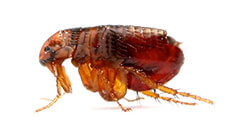Controlling Fleas and Ticks in Goderich
During the spring and summer months, residents of Goderich, ON may notice a variety of pests in and around their homes. These months are particularly high in pest activity due to the reproductive habits and behavioral traits of many of Goderich’s common pests.
Ticks and fleas are no exception with April to September being prime months for both of these parasites to inflict the most damage.
Fleas and ticks can indeed pose a challenging pest control problem in the Goderich area affecting both pet and non-pet owners.
Below, Truly Nolen Goderich takes a closer look at the potential dangers of fleas and ticks, in addition to providing tips for identification, control and special concerns for parents and pet owners.
Fleas & Ticks – What’s the difference?

Fleas are blood sucking parasites that are typically no more than 1/8 of an inch and are small and flat. The most common varieties feed off the blood of mammals, which means that dogs and cats (as well as us humans) are at risk of being bitten. Though microscopic, fleas can be spotted on pets, but will move quickly to get out of sight, including jumping up to 7 inches in the air!

Ticks on the other hand, are slightly larger and are part of the Arthropod family. This means, that they are technically considered to be Arachnids and share 8 legs in common with the spider. Their bodies can be hard or soft, and their sharp mouths are used to attach themselves to their prey. A female tick can often draw enough blood from her victim to make her swell to many times her weight and size.
In a summary, the main differences between fleas and ticks are:
- Fleas can jump and will bite and then move quickly to the next area. On the other hand, ticks are slow and will crawl over their victim and can nestle in one spot and feed for days before falling off.
- Flea bites can cause itching and dermatitis, while ticks should be taken more seriously as they are able to transmit diseases.
Dangers of Fleas & Ticks
For pet owners and non- pet owners, the dangers of fleas and ticks can have adverse effects on us all.
Truly Nolen Goderich takes a look at some of these more common dangers including:
Tapeworm
Tapeworms are long, flat worms that attach themselves for extended periods of time, to the intestines of both humans and animals such as dogs. Tapeworms can reside within a flea, which can then be transmitted to another host, such as your pet.
Lyme disease
Carried by deer ticks, Lyme disease is an infection caused by a type of bacteria called ‘spirochete’ that is transmitted to both humans and animals when bitten by these ticks. If Lyme disease is caught in the early stages, it can be cured; however the danger in the disease lies in transmission through the bloodstream and into the nervous system and joints. If left untreated for an extended time, symptoms can be persistent and last for as long as several years after treatment is finally administered.
Tips for identification and control
For both pet owners, as well as parents, knowing what to look out for if you suspect your home may have a flea or tick problem, is important for the safety and well-being of your entire family.
Flea/Tick Identification in pets
For the health and well-being of your pets, taking note of the warning signs could help eradicate the problem before it worsens:
- Intense itching, scratching or licking
- Red, irritated skin or scabs
- Droppings (dark specks) seen on the skin of your pet, between the fur
Flea/Tick Identification in humans
Unlike a mosquito bite that will swell in size after being bitten, flea or tick bites remain small but offer several warning signs including:
- Several small, red lumps aligned in groups of three or four
- A red “halo” around the center of the bite
- Bites on parts of the body that are usually exposed, such as ankle
- Signs of a rash developing near the bite
Flea/Tick control
At Truly Nolen Goderich, we provide flea and tick control foboth residential and commercial customers. Though professional help is recommended, we also encourage homeowners to take preventative measures that can help a potential flea or tick problem from getting out of hand.
- For pet owners, fleas can easily be transported from the exterior of the home, to inside. It is important that pets are frequently checked, as well as taken to the vet right away if there is a suspicion of fleas or ticks on the animals
- Pet blankets should be washed frequently in hot, soapy water and put to air dry in the sun.
- For homeowners without pets, special attention should be paid to the exterior environment such as decks and yards. Fleas and ticks stay away from the sun, so shaded areas should be kept clutter free to avoid providing them with nesting sites. Since fleas like tall grass, keeping your grass consistently cut prevents these parasites from finding places to live.
Truly Nolen Goderich is here to help homeowners battle their flea and tick problems. We remind residents that these parasites do not only invade spaces where pets are present! Pet owners and parents should be vigilant especially during the summer months when fleas and ticks are anxious to hide from the sun, and find a shadier place to call home.
Whether you have pets or not, if you suspect that fleas and ticks may have invaded your space, contact your Truly Nolen Goderich team today at 519-524-5052 to schedule an inspection.